Jeeter
XS650 Addict
Rustoleum High Heat Ultra
(Engine pics below - 1982 Yamaha XJ650J engine I painted with this stuff) I applied this using a small Harbor Freight airbrush kit that we had here for another project (the whole kit was like $70 bucks and that included a small air compressor, it's worked fine for many jobs). However this paint comes in rattlecan, as well as quarts and gallons.
It's a nice flat paint, with a good rough surface area. I grew up around guys that taught us kids to paint our aircooled engines with flat black paint since flat black had a rough surface (and therefore MORE surface area) which provides more surface to disipate heat. I guess that old idea sticks in my mind. That concept was so massively accepted that many road racers during the late 1970s and early 1980s went to great lengths to coat their engines with stuff known as "Kal Gard". In 1979 I know it cost us just under $100 bucks to do one of our racebikes (RD350). Engine must be completely torn down to apply Kal Gard because it has to be baked after application.
Kal Gard was a substance designed to protect weapons of underwater demolition teams from the effects of salt water. It was discovered that it also worked very well to dissipate heat from engines. It had a nice sortof black-grey shade to it. Aluminum Oxide medium was used to blast the surfaces of the engine to create an irregular surface area that was over five times it's original area (this increase is microscopic and cannot be seen with the naked eyebone). Kal Gard is only 0.0003 inches thick when sprayed on and baked. The Kal Gard is so thin that it easily follows the micro-contours that the aluminum-oxide blasting created, so not only do you have 5x more surface area, but that area is coated with a substance that helps suck heat from the engine. This process reduced engine temps by a whopping 15%. That is A LOT. Think of it, that's 15 degrees for every one hundred. So if you previously had oil temps of (let's say) 280f, that was reduced to 238f .... that's a whopping 42f degrees. That's 42f degrees of potentially more power that you can attempt to squeaze from the engine before it melts down. Or, it's just that much more power at the last 2 or 3 laps of a race while your competition's bikes were "glowing and slowing" (slowing down from the engines' getting hot).
Anyhow, I don't think this Rustoleum is anything as trick as Kal Gard, but the principle is the same. What is pretty cool about the Rustoleum is the color. It's not the typical flat black tint, it has a sortof greyish-brownish hue to it, which (to me) gives it a sortof "secret" or "prototypical" look about it. In the picture of the engine on the wooden pallet (I made that to ship that engine) you can get a better idea of it's daylight color. It looks kinda like Kal Gard, uh, sorta. The pictures of the early 80s Superbikes (my other motorcycling weakness) show engines covered with Kal Gard, you can see what that stuff looked like in those pics.
The Rustoleum "Specialty High Heat Ultra" covers fine, and is quite friendly with total non-painter types like myself. It's advertized to be good up to 1,200f.
So, yea ... um ... there's that.
(Engine pics below - 1982 Yamaha XJ650J engine I painted with this stuff) I applied this using a small Harbor Freight airbrush kit that we had here for another project (the whole kit was like $70 bucks and that included a small air compressor, it's worked fine for many jobs). However this paint comes in rattlecan, as well as quarts and gallons.
It's a nice flat paint, with a good rough surface area. I grew up around guys that taught us kids to paint our aircooled engines with flat black paint since flat black had a rough surface (and therefore MORE surface area) which provides more surface to disipate heat. I guess that old idea sticks in my mind. That concept was so massively accepted that many road racers during the late 1970s and early 1980s went to great lengths to coat their engines with stuff known as "Kal Gard". In 1979 I know it cost us just under $100 bucks to do one of our racebikes (RD350). Engine must be completely torn down to apply Kal Gard because it has to be baked after application.
Kal Gard was a substance designed to protect weapons of underwater demolition teams from the effects of salt water. It was discovered that it also worked very well to dissipate heat from engines. It had a nice sortof black-grey shade to it. Aluminum Oxide medium was used to blast the surfaces of the engine to create an irregular surface area that was over five times it's original area (this increase is microscopic and cannot be seen with the naked eyebone). Kal Gard is only 0.0003 inches thick when sprayed on and baked. The Kal Gard is so thin that it easily follows the micro-contours that the aluminum-oxide blasting created, so not only do you have 5x more surface area, but that area is coated with a substance that helps suck heat from the engine. This process reduced engine temps by a whopping 15%. That is A LOT. Think of it, that's 15 degrees for every one hundred. So if you previously had oil temps of (let's say) 280f, that was reduced to 238f .... that's a whopping 42f degrees. That's 42f degrees of potentially more power that you can attempt to squeaze from the engine before it melts down. Or, it's just that much more power at the last 2 or 3 laps of a race while your competition's bikes were "glowing and slowing" (slowing down from the engines' getting hot).
Anyhow, I don't think this Rustoleum is anything as trick as Kal Gard, but the principle is the same. What is pretty cool about the Rustoleum is the color. It's not the typical flat black tint, it has a sortof greyish-brownish hue to it, which (to me) gives it a sortof "secret" or "prototypical" look about it. In the picture of the engine on the wooden pallet (I made that to ship that engine) you can get a better idea of it's daylight color. It looks kinda like Kal Gard, uh, sorta. The pictures of the early 80s Superbikes (my other motorcycling weakness) show engines covered with Kal Gard, you can see what that stuff looked like in those pics.
The Rustoleum "Specialty High Heat Ultra" covers fine, and is quite friendly with total non-painter types like myself. It's advertized to be good up to 1,200f.
So, yea ... um ... there's that.
Attachments
-
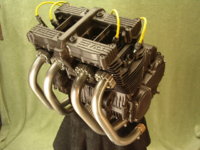 IMGP4793.JPG296.3 KB · Views: 630
IMGP4793.JPG296.3 KB · Views: 630 -
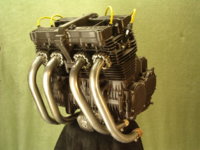 IMGP4796.JPG287.2 KB · Views: 671
IMGP4796.JPG287.2 KB · Views: 671 -
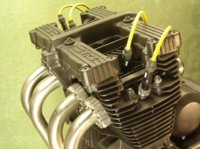 IMGP4806.jpg57 KB · Views: 723
IMGP4806.jpg57 KB · Views: 723 -
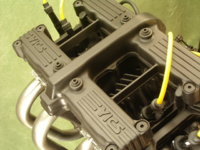 IMGP4811.JPG270.9 KB · Views: 646
IMGP4811.JPG270.9 KB · Views: 646 -
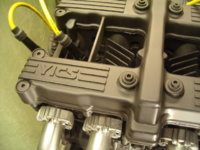 IMGP4820.JPG261.3 KB · Views: 1,203
IMGP4820.JPG261.3 KB · Views: 1,203 -
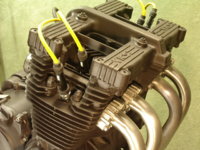 IMGP4841.JPG298.8 KB · Views: 663
IMGP4841.JPG298.8 KB · Views: 663 -
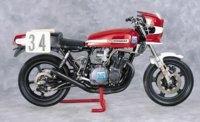 Wes Cooleys Yoshimura Suzuki - 1.jpg69.6 KB · Views: 729
Wes Cooleys Yoshimura Suzuki - 1.jpg69.6 KB · Views: 729 -
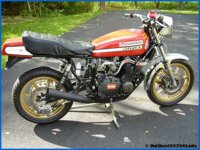 Roberto Pietris 1979 Yoshimura Suzuki that he whored out to Honda - note gas welded frame - 021.jpg107.2 KB · Views: 710
Roberto Pietris 1979 Yoshimura Suzuki that he whored out to Honda - note gas welded frame - 021.jpg107.2 KB · Views: 710 -
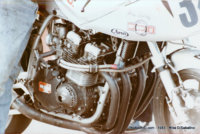 June1983_128.jpg184.3 KB · Views: 572
June1983_128.jpg184.3 KB · Views: 572 -
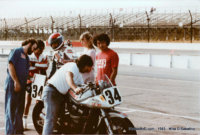 June1983_127.jpg209 KB · Views: 553
June1983_127.jpg209 KB · Views: 553 -
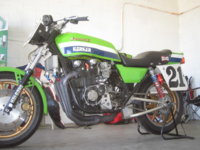 IMG_3460.jpg136.9 KB · Views: 711
IMG_3460.jpg136.9 KB · Views: 711 -
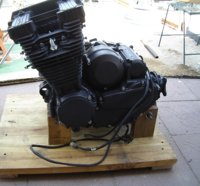 IMGP5663.JPG214.4 KB · Views: 655
IMGP5663.JPG214.4 KB · Views: 655
